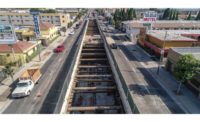Phase 2 of the Los Angeles Metropolitan Transportation Authority Expo Light Rail project is closing in on its quest to reach the Pacific by 2015. About 45% complete as of late July, the $1.5-billion, 6.6-mile-long line from Culver City to Santa Monica faces obstacles above and below ground.
The project continues the Expo Line's $930-million, 8.6-mile-long Phase 1, which opened last year and links downtown Los Angeles with Culver City. Phase 2 broke ground last summer and will extend the line to Santa Monica. The new phase includes seven major bridges, seven stations—divided into 25 design packages—and a railcar maintenance and parking facility.
When complete in 2015, the project will have used more than 9.3 million lb of rebar and 20,558 cu yd of concrete on the bridges, walls and sidewalks, and workers will have excavated about 371,607 cu yd of earth.
The alignment, primarily at grade, will parallel the I-10 freeway and run along the old right-of-way of the Pacific Electric Exposition—an electric trolley line used in the early 20th century—to 4th Street and Colorado Avenue in downtown Santa Monica.
Maze of Utilities
A particular construction challenge along the route has been dealing with a web of underground utilities.
The proximity to busy city streets and neighborhoods has made coordination between the project team and local utility companies especially important, says Eric Olson, chief project officer for the Exposition Construction Authority, which oversees the project.
"One thing we did on this job that was unique was facilitated partnering with each utility in an effort to bring them in as part of the project team," Olson says. "This is my fourth design-build [project] and this is the first time we've done something like this. And it's proved to be effective."
He adds, "Design-build projects move very fast .... By getting [utilities] in early, we are getting them to keep up with our pace."
Rick Thorpe, Construction Authority CEO, says, "A lot of times third parties aren't staffed for such a big project" and sometimes may need the contractor to take over certain major project tasks.







Post a comment to this article
Report Abusive Comment